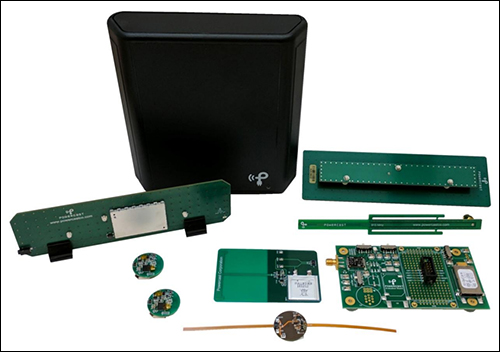Jun 11, 2018Powercast is releasing a new power-harvesting RFID label this year, known as the Batteryless Electronic UHF Retail Price Tag, that enables RFID-based updating of electronic paper (e-paper) information, such as prices for retailer shelves. The company is partnering with systems integrators that could develop their own solution for stores.
The "power-over-distance" wireless charging price tag has a built-in UHF RFID transponder and an E Ink display screen, as well as Powercast's PCC110 Powerharvester chip. When interrogated, the label can not only follow a command sent by that interrogator—such as changing pricing information—but it also uses RF-to-DC power harvesting to enable those actions, says Charles Greene, Powercast's COO and CTO.

In 2017, Powercast released an RFID sensor tag known as the PCT100, which uses the power of an interrogator to energize sensors and respond with sensor data via a UHF transmission. The tag can include temperature, humidity and light sensors (see Powercast Aims RF-based Charging Kit at Consumer Goods).
Powercast's latest product takes aim at the retail market, however. Many retailers, especially large chain companies, change their prices and other descriptive data on shelf labels on a regular basis, often company-wide. A store headquarters assigns a new price, such as a temporary discount, and locations across a particular region, or the entire United States, must then go about changing those prices.
When paper shelf labels are used, new labels must be printed and manually replaced. Electronic shelf labels offer an alternative, the company reports. Electronic shelf labels can be expensive, and most are wired to enable communication with a back-end server that sends pricing updates. Alternatively, the labels could include batteries to power the capture and display of RFID-based data, but those batteries would then need to be replaced—and if there were thousands of labels in use at a large store, keeping track of the batteries could be an exhaustive process.
With Powercast's battery-less price label, a store associate requires only a handheld reader that stores pricing data or can access that information via a Wi-Fi connection. Stores could configure the software in a multitude of ways, such as linking each unique ID number on a label with a specific product, so that the new prices could be linked to that ID during interrogation. Conversely, stores could link changes to a zone of products—for instance, a handheld reader could access prices for a particular department (housewares, for example) by reading a tag ID dedicated to that zone. Scanning bar codes would be another alternative to link a specific zone or stock-keeping unit (SKU) to specific price changes, Greene says.
When the handheld device comes within approximately 2 meters (6.6 feet), the labels are energized with RF power, which they then convert to DC. They send a response in the form of a unique ID, and the handheld reader identifies that tag and transmits instructions to change the content on its e-paper display. The handheld then displays information for the user regarding which labels have been updated. That data, if stored in the cloud, could then be accessed by store management.
Some stores are investigating the option of using the system with fixed readers, Greene reports. For instance, several retailers already have fixed readers installed in their facilities, and they would use that existing infrastructure to update pricing on the Powercast tags. In the case of fixed readers, he notes, the system could be configured to send data at a distance up to 10 meters (32.8 feet), while the capture of data and sufficient power to update the e-paper display would take somewhat longer—about 45 seconds.
"The physical energy needed to change the screen would require a longer interrogation time," Greene says, because the transmission comes from a longer distance. This could be accomplished during off-business hours, such as at 2 AM, Greene explains, so that the long transaction time would not be a challenge.
The solution also works for other applications beyond retail, such as health care. The e-paper—which uses a segmented display—can display both words and numbers, so a reader could update information such as whether supplies on a shelf or in a drawer require replenishment, for instance. "Each user may have their own product requirements" for labels, Greene says, and Powercast will work with solution providers to develop a specific label for each use case.
An evaluation kit for the Batteryless Electronic UHF Retail Price Tag is expected to be made available in the fourth quarter of 2018, from distributors Arrow Electronics and Mouser Electronics. Powercast will work with partners to design their own battery-less price tags using Powercast's PCC110 chip—the same power-harvesting RF-to-DC converter chip used in the PCT100 sensor tag, as well as an NXP Semiconductors UCODE RFID chip.
Later this year, the company intends to release a PowerSpot TX91503 transmitter that can send an RF signal to a device, such as consumer electronics-based headphones or game controllers, in order to wirelessly charge it at a distance of up to 3 feet.

